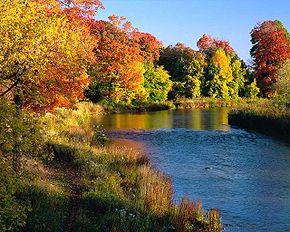It's been beautiful here in the Ohio Valley. Sunny warm days and cool nights. Some say it's Indian Summer. So here's a little on Indian Summer and our Fall Harvests.
 |
| A typical day within a period of "Indian Summer" |
An Indian summer is a period of unseasonably warm, dry weather, occurring after the end of summer proper. The US National Weather Service defines this as where the weather is sunny and clear, and above 21 °C (70 °F), after there has been a sharp frost; a period normally associated with late-October to mid-November.
In some regions of the southwestern United States, 'Indian summer' is colloquially used to describe the hottest times of the year, typically in late July or August. But in the South, as elsewhere in the US, this period is more commonly known as the dog days, in reference to the position of Sirius, the 'Dog Star' and brightest star in the sky (other than the Sun and the planets). In the desert southwestern United States, where frost is rare, the term is sometimes used to refer to a brief period of hot dry weather which occurs after the hottest months and before the onset of winter cool and/or rain, typically in October or November. It may also be used to refer to any unseasonably warm weather during the first few weeks of the rainy season, before the approach of spring. In the Pacific Northwest, the term can be used to describe a period of warm, dry weather after the first fall rains have occurred. A famous use of the phrase in American literature is Van Wyck Brooks' New England: Indian Summer, a sequel to his Pulitzer Prize-winning The Flowering of New England.
In the United Kingdom an Indian summer is often used to describe warm weather that comes later in the year, after unusually cool summer months.
Good Crops for Fall Harvests
Many of the veggies that are harvested in fall—the ones you're beginning to see in farmers markets now—actually need to be planted in mid- to late-summer. See SparkPeople's excellent resource on vegetable gardening for info on when and how to plant these crops.
Crucifers
Broccoli, cabbage, Brussels sprouts and cauliflower—those staples of the fall dinner table— thrive in autumn weather, and their flavors benefit from colder temps. They can be planted in fall in more southern zones, but need to be started from seed indoors. Plan now for next summer; start seedlings in midsummer and plant in late summer for a fall harvest.
 |
| Yellow Squash |
Acorn, butternut, pumpkin and other winter squash varieties are not only delicious, but they're traditional in fall and holiday decor. These, too, must be planted in summer for a fall harvest, as they take up to 100 days to maturity and like lots of sun. And they take up significant growing space, often sending out long vines that need room to move. Plan now for next summer.
Dark Greens
Leafy, hearty, nutrient-packed greens like kale and chard are also commonly found at farmers' markets in the fall; they, too, need time to reach maturity (about two to two and a half months). While they can tolerate cool fall weather, they require full sun and should be planted in late summer to reach full production.
No comments:
Post a Comment